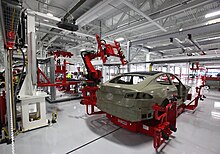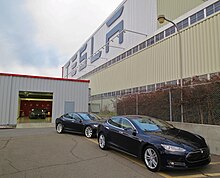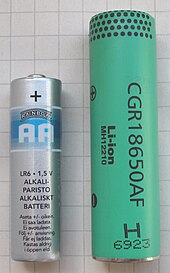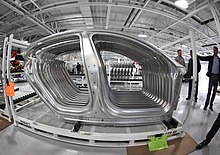Tesla Fremont Factory
 A Tesla Model S being manufactured at the Tesla Factory | |
| Industry | Automotive industry |
|---|---|
| Predecessor |
|
| Founded | 2010 |
| Headquarters | Fremont, California, United States |
| Products | Battery electric vehicles |
| Services | Automotive manufacturing |
| Owner | Tesla Motors |
| Website | Official website |
The Tesla Factory is an automobile manufacturing plant in Fremont, California, US, and the principal production facility of Tesla Motors. The facility was formerly known as New United Motor Manufacturing, Inc. (NUMMI), a joint venture between General Motors and Toyota.[1] The plant is located in the East Industrial area of Fremont between Interstates 880 and 680.
History
Tesla Motors had planned for an assembly factory in Albuquerque, New Mexico, as a central location for shipping.[2][3] Construction was supposed to begin in April 2007, but was canceled.[4]
A separate greenfield factory to be built in San Jose, California was also announced.[5] However, the cost was prohibitive, and the company looked for alternatives.
The current facility was opened in 1962 as the GM Fremont Assembly, and later used as a plant for New United Motor Manufacturing, Inc. (NUMMI), a joint venture between General Motors and Toyota.[6][1] The plant is located in the East Industrial area of Fremont between Interstates 880 and 680 and employs around 3,000 people.[7]
On May 20, 2010, Tesla Motors and Toyota announced a partnership to work on electric vehicle development and collaborate on the "development of electric vehicles, parts, and production system and engineering support". This included Tesla's partial purchase of the former NUMMI site, mainly consisting of the factory building,[8][9] for $42 million.[10][11]
Tesla Motors officially took possession of the site on October 19, 2010,[12] and opened it on October 27.[13] The state of California has supported the renewal, expecting tax income from sustained jobs.[14][15] The first retail delivery of the Tesla Model S took place during a special event held at the Tesla Factory on June 22, 2012.[16]
Facilities
Much of the 370-acre (16,000,000 sq ft; 1,500,000 m2) site is unused, with most activity concentrated in the 5,500,000-square-foot (510,000 m2) main building that does the final assembly of vehicles.[12]
Various parts of the NUMMI plant were planned to be modified to support Tesla vehicle production. For example, the passenger vehicle paint equipment was to be extensively modified through late 2011.[12][needs update]
Over $17 million of manufacturing equipment and spare parts were acquired from NUMMI and Toyota in 2011, at significant discounts compared to new equipment.[17]
The floors, walls and ceiling are painted white with skylights and high-efficiency lighting to create an environment similar to a laboratory.[18]
Tesla is building a casting foundry in Lathrop supporting the Fremont production.[19][20][21]
Employees
Tesla Motors started production with 1,000 workers.[22] By 2013, this had risen to 3,000.[23]
Production

The plant's first series production vehicle is the Tesla Model S full-sized battery electric sedan.
In 2011, Tesla Motors transitioned from hand-assembled "alpha builds" to "beta builds", production-validation vehicles built entirely at the Tesla Factory. These cars would also be used for system integration, engineering testing, and federal crash-testing and certification.[24] Tesla expected to produce about 5,000 Model S sedans in 2012, with production ramping up to 20,000 in 2013 if necessary.[25] The first retail delivery of the Model S took place during a special event held at the Tesla Factory on June 22, 2012.[16]
Production grew from 15–20 cars completed/week in August 2012[26] to over 200 by November 5[27] and 400 by late December.[28][29] In late December Tesla revised their 2012 delivery projections down to 2,500 cars.[30]
Deliveries reached 6,892 units in the last three months of 2013.[31] In December 2013, California announced it would give Tesla a US$34.7 million tax break to expand production by an estimated 35,000 vehicles annually from its Fremont, California plant.[32]
Tesla announced that production was expected to climb from 600 cars per week in early 2014 to about 1,000 units per week by year-end.[33] Tesla produced 7,535 units during the first quarter of 2014, and expected to produce 8,500 to 9,000 cars in the second quarter of 2014. As of early May 2014, the production rate was 700 cars per week.[34]
As of 2015[update], about 1,000 cars are made per week,[35][36] mostly to pre-orders.[37] Musk says they average around 20 changes to the S per week.[38]
Production of the future Model X will join the Model S during 2015,[39] following a short reconfiguration of the production line in July 2014.[40]
On July 2, 2015, Tesla Motors announced that it had delivered a total of 21,537 vehicles in the first half of 2015. All vehicles were manufactured at the Fremont plant.[41]
Tesla Model S manufacturing process
The manufacturing process uses more than 160 specialist robots including 10 of the largest robots in the world,[7] named after X-Men characters.[42][43][44] Many of the Model S's unique components, including the battery pack, battery module, and drive units are manufactured in-house. The plant has a high level of integration compared with other modern car assembly plants, with most processes taking place within the Tesla Factory. This includes most of the stamping and machining, painting, and some coding. The hydraulic press lines used to stamp the body panels are the largest in North America and the 6th largest in the world.[45] Around 60% of the car parts are sourced from North America.[46] Design engineers also work at the factory itself, rather than a separate facility.[6][47]
Each vehicle is made to order with a two to three-month wait time for delivery,[48] although individual vehicles only take between three to five days to complete the assembly process.[7] Tesla prefers delivery by train rather than by truck, as costs and damages are less.[37]
Drive unit construction
Motor construction

The alternating current electric motor is constructed in-house. The main components of the motor are the stator and rotor.[49]
The motor construction begins when a robot unspools and winds over 1⁄2 mile (0.80 km) of copper wire per motor. It then pulls the copper wire into a stack. The motor has three phases and so requires three coils of copper.[49] A worker then lengthens and straightens each bundle of wire and inserts the hydraulic lift to transfer the motor to the next station.
A worker insulates each bundle of copper wire in a plastic sleeve to prevent the bundles from touching one another. The ends of the bundles are then snipped to the correct length. Lugs are added and crimped to form attachment points for the motor's three phases.[49] A specialized automatic sewing machine then binds the coils together to keep them in place, the increased tightness of the binding provided by a robotic sewing machine increases the efficiency of the motor. The stator is then encased in a two part epoxy resin to help in evenly distributing the motor's heat. The stator is now complete and is inserted into a heated metal case, locking the stator inside as the case cools.[49]
A worker uses a hoisting system to insert the rotor inside the stator completing the construction of the motor.
Additional drive unit components
A worker then installs the differential and other sections of the gearbox, attaching it together using bolts. An air leak test is then conducted. The three phase tripole power inverter is then installed onto the top of the motor to convert direct current from the battery into alternating current for the motor to use. The motor then undergoes a series of automated tests taking 4 minutes to ensure correct function, and then is moved to the general assembly area to be installed into the car.[49]
Battery pack construction

The Model S 85s battery pack contains 7,104 '18650' lithium-ion battery cells in 16 modules[50] wired in series (14 in the flat section and two stacked on the front).[51] Each module contains six groups[52] of 74 cells[53] wired in parallel; the six groups are then wired in series within the module.[53][54][55][56] As of June 2012[update] the battery pack uses modified Panasonic NCR18650A 3100mAh cells with nickel-cobalt-aluminum cathodes.[57][58]
The use of commodity cells, similar to those found in laptops and mobile phones, is in contrast to every other electric vehicle manufacturer who use specialized large format Li-Ion cells.[59] The liquid-cooled battery pack uses an intumescent gel to aid in fireproofing and even heat distribution.
Body construction
Aluminium coil blanking
98% of the Tesla Model S body is constructed from aluminium[49] and is produced from between 50 to 60 separate coils of aluminium each for various components. The coils are unwound, flattened and cut in a blanking machine; additional cutting is also done using laser cutter. The total weight of the aluminium used in the Model S is around 410 pounds (190 kg).[7]
Tandem press lines

A robot then transfers the aluminium blanks into the tandem press lines where the sheets are stamped into the various panels of the cars. The Schuler SMG hydraulic stamping press line is the largest in North America and the 6th largest in the world.[45] The presses use up to 11,000 ton-force to form the body panels; the upper section applies 1400 tonnes of downward force and the lower section 130 tonnes.[49] The blank aluminium sheet is stretched over the lower draw die and openings are cut with robots transferring the panels between processes. The workers then inspect each panel to ensure correct pressing. The parts are then stacked in frames and stored. The machines press one part every 6 seconds and create 5,000 parts per day.[7]
Drive unit installation
The car is raised and the drive unit is installed into the rear axle assembly. The drive unit provides power directly to the wheels without a drive shaft.[49]
Battery pack installation
The battery pack weighs almost 1,200 pounds (540 kg) and is delivered to the installation area and is raised into the car using a lift. Placing the battery pack under the cabin floor adds strength and rigidity to the car and lowers the vehicle's centre of gravity[49] to 18 inches (46 cm).[60][61] A titanium plate is installed over the battery pack which protects it in the event of a high-speed collision and to protect from road debris.[62][63]
Safety
In November 2013 there was an accident when the low-pressure aluminum casting press failed, spilling molten metal on three workers and causing their clothing to catch fire. Tesla was fined US$89,000 by the California Division of Occupational Safety and Health for seven safety violations, six considered serious.[64]
See also
References
- ^ a b Sibley, Lisa (October 27, 2010). "Tesla officially replaces NUMMI in Fremont".
- ^ "Tesla Motors press release - announcement of Albuquerque plant". Teslamotors.com. Archived from the original on April 6, 2010. Retrieved November 27, 2010.
{{cite web}}: Unknown parameter|deadurl=ignored (|url-status=suggested) (help) - ^ Severns, Dave. "Tesla Motors blog post regarding Albuquerque decision". Teslamotors.com. Archived from the original on March 17, 2007. Retrieved November 27, 2010.
{{cite web}}: Unknown parameter|deadurl=ignored (|url-status=suggested) (help) - ^ "The Albuquerque Tribune Editorial: Don't hold your breath on Tesla Motors plant". Abqtrib.com. Retrieved November 27, 2010.
- ^ "Tesla to build electric car factory in Bay Area - San Jose Mercury News". Mercurynews.com. Archived from the original on September 20, 2012. Retrieved November 27, 2010.
{{cite web}}: Unknown parameter|deadurl=ignored (|url-status=suggested) (help) - ^ a b "How Tesla Builds Electric Cars , Tesla Motors Part 2 (WIRED)". Wired.com. WIRED. Retrieved April 2, 2015.
- ^ a b c d e "How the Tesla Model S is Made , Tesla Motors Part 1". Wired.com. WIRED. Retrieved April 1, 2015.
- ^ Lindsay Riddell (April 20, 2010). "Tesla to buy NUMMI plant, build cars with Toyota". San Francisco Business Times. Retrieved May 21, 2010.
- ^ "Tesla Wants NUMMI Operational By 2012". KVTU.com. May 21, 2010. Retrieved May 22, 2010.
- ^ Baker, David R. (April 28, 2010). "Tesla paid only $42 million for Nummi plant". San Francisco Gate.
- ^ Tierney, Christine (May 20, 2010). "Toyota invests in Tesla to help reopen Calif. plant". The Detroit News. Retrieved May 22, 2010.[dead link]
- ^ a b c PUI-WING TAM (October 21, 2010). "Idle Fremont Plant Gears Up for Tesla". Wall Street Journal. Retrieved April 3, 2011.
- ^ "Tesla Motors Opens Tesla Factory - Home of the Model S" (Press release). Tesla Motors. October 27, 2010. Retrieved July 18, 2012.
- ^ Jerry HirschJerry Hirsch (May 30, 2015). "Three companies, $4.9 billion in government support". Los Angeles Times. Archived from the original on October 25, 2015. Retrieved October 29, 2015.
{{cite web}}: Unknown parameter|deadurl=ignored (|url-status=suggested) (help) - ^ "Musk defends receiving $4.9 billion in government support for Tesla, SolarCity and SpaceX". RT English. Retrieved October 29, 2015.
{{cite web}}: Unknown parameter|deadurl=ignored (|url-status=suggested) (help) - ^ a b John Boudreau (June 22, 2012). "In a Silicon Valley milestone, Tesla Motors begins delivering Model S electric cars". San Jose Mercury News. Retrieved June 22, 2012.
- ^ "Tesla Motors Reports Fourth Quarter And Full Year 2010 Results". TheStreet. February 15, 2011. Retrieved September 18, 2014.
- ^ "Tesla Factory". Teslamotors.com. Retrieved March 8, 2015.
- ^ Elon Musk is ecstatic about Powerwall demand - Tesla Q1 2015 Earnings call (2015) AUDIO. at 1h02m
- ^ "Tesla Motors (TSLA) Earnings Report: Q1 2015 Conference Call Transcript". TheStreet. May 7, 2015. p. 12. Retrieved May 11, 2015.
- ^ "Tesla Motors (TSLA) Elon Reeve Musk on Q1 2015 Results - Earnings Call Transcript". Seeking Alpha. May 7, 2015. Retrieved May 15, 2015.
- ^ Baker, David R. (June 22, 2012). "Tesla starts delivery out of former Nummi plant". The San Francisco Chronicle.
- ^ "Peek Inside Tesla's Robotic Factory". Wired. July 16, 2013. Retrieved December 31, 2014.
- ^ Squatriglia, Chuck (January 6, 2011). "Tesla Wants Some Engineering Cred". Wired.com.
- ^ Ohnsman, Alan (March 7, 2010). "Tesla Model S Assembly to Begin With Highest-Priced Version". Bloomberg. Retrieved April 3, 2011.
- ^ Blankenship, George (August 21, 2012). "Inside Tesla". Tesla Motors. Retrieved August 24, 2012.
- ^ Tesla Motors (November 5, 2012). "Tesla Motors, Inc. – Third Quarter 2012 Shareholder Letter". Tesla Motors. Retrieved December 1, 2012.
- ^ Domenick Yoney (February 20, 2013). "Tesla delivered 2,650 Model S EVs last year, Musk confident of profit in Q1 and beyond". Autoblog Green. Retrieved March 10, 2013. Around 2,650 Model S cars were delivered in the U.S. during 2012.
- ^ Michael Graham Richard (January 30, 2013). "Tesla Reaches 20,000 Unit Production Rate Annually for Model S". treehugger.com. Retrieved February 5, 2013.
- ^ "Make Way for Kilowatts: A Growing-Up Year for Plug-Ins". New York Times. December 21, 2012. Retrieved December 24, 2012.
- ^ Ashlee Vance (February 19, 2014). "Tesla's Stock Remains Electric on Higher Sales Forecast". Bloomberg Businessweek. Retrieved February 19, 2014.
- ^ Antony Ingram (December 18, 2013). "Tesla To Add Production Capacity For 35,000 More Electric Cars". greencarreports.com. Retrieved December 18, 2013.
- ^ Jerry Hirsch (February 19, 2014). "Tesla Motors ends year with higher sales but still a big loss". Los Angeles Times. Retrieved February 19, 2014. A total of 22,477 Model S sedans were sold in 2013.
- ^ Tesla Motors (May 7, 2014). "First Quarter 2014 Shareholder Letter" (PDF). Tesla Motors. Retrieved June 1, 2014.
- ^ Gordon-Bloomfield, Nikki (May 6, 2015). "Tesla Motors Posts Q1 2015 Losses, Due to Strong Dollar, High Capital Expenditures. Hits 1,000 Car/Week Model S Production". Transport Evolved. Retrieved May 8, 2015.
- ^ Murph, Darren (May 20, 2010). "Tesla lands sudden deal with Toyota, will build Model S sedan in Fremont NUMMI plant". Engadget. Retrieved September 24, 2011.
- ^ a b "Tesla Motors (TSLA) Earnings Report: Q1 2015 Conference Call Transcript". TheStreet. May 7, 2015. p. 8. Retrieved May 11, 2015.
- ^ Reynolds, Kim (November 3, 2014). "2015 Tesla Model S P85D First Test". Motor Trend. Retrieved May 15, 2015.
- ^ "Tesla Motors (TSLA) Earnings Report: Q1 2015 Conference Call Transcript". TheStreet. May 7, 2015. p. 15. Retrieved May 11, 2015.
- ^ "Tesla idles Fremont production line for Model X upgrade". San Jose Mercury. July 22, 2014. Retrieved December 31, 2014.
- ^ "Tesla Delivers 11,507 Vehicles in Q2 of 2015". Tesla Motors. July 2, 2015. Retrieved July 8, 2015.
- ^ Richard, Michael Graham (November 21, 2014). "Tesla's factory upgrade: X-Men characters, climbing plants, giant robots, murals, etc". TreeHugger. Retrieved May 12, 2015.
- ^ Shahan, Zachary (November 18, 2014). "Tesla Robots Get X-Men Names". Clean Technica. Retrieved May 15, 2015.
- ^ "At Tesla, Workers Team Up With Robot Superheroes". The Wall Street Journal. April 15, 2015. Retrieved May 15, 2015.
- ^ a b "Can Tesla become a bigger company with Model S electric car? That's Elon Musk's gamble". Autoweek.com. Autoweek. Retrieved April 26, 2015.
- ^ "Tesla Motors (TSLA) Earnings Report: Q1 2015 Conference Call Transcript". TheStreet. May 7, 2015. p. 14. Retrieved May 11, 2015.
- ^ "During summer factory upgrade, Tesla installed 10 of the largest robots in the world". electrek.co. Electrek. Retrieved April 26, 2015.
- ^ "Electric Car Quality Tests , Tesla Motors Part 3 (WIRED)". wired.com. WIRED. Retrieved April 2, 2015.
- ^ a b c d e f g h i "How Its Made Dream Cars Season 02 Episode 10 Tesla Model S". How Its Made. Retrieved April 2, 2015.
- ^ Musk, Elon (October 4, 2013). "Model S Fire". Tesla Motors. Retrieved February 20, 2014.
- ^ Cunningham, Wayne (October 6, 2010). "Tesla Model S: The battery pack". C|Net. Retrieved February 20, 2014.
- ^ stopcrazypp. "NHTSA Opened Up the Model S Battery Pack - Pics". Tesla Motors Club Forum. Retrieved February 20, 2014.
We know from the diagnosis screen that the 85 kWh pack has 16 modules with 6 groups in series (so 96 groups in series):[1]
{{cite web}}: External link in|quote= - ^ a b US patent 8286743, Rawlison, Peter Dore, "Vehicle Battery Pack Ballistic Shield", issued 2012-10-16
- ^ US patent 2007009787, "Method and Apparatus for Mounting, Cooling, Connecting, and Protecting Batteries", issued 2007-1-11
- ^ Beltran, Balbino A.; Dunlap, Michael L.; Richardson, Frank D. (August 7, 2013). "REPORT NUMBER: NCAP305I-KAR-13-054 NEW CAR ASSESSMENT PROGRAM (NCAP) FMVSS NO. 305 INDICANT TEST TESLA MOTORS, INC. 2013 TESLA MODEL S 5-DOOR HATCHBACK NHTSA NUMBER: MD5001" (NCAP305I-KAR-13-054). U.S. Department of Transportation, National Highway Safety Adminitstration: A-13. Retrieved February 20, 2014.
{{cite journal}}: Cite journal requires|journal=(help) - ^ Josie Garthaite (June 23, 2012). "Leaving Baggage On the Dock, a Flagship Departs From California". The New York Times. Retrieved June 24, 2012.
- ^ "Charge your Model S - Adapter Guide, High Power Charging, and Supercharge". Tesla Motors. Retrieved June 23, 2012.
- ^ Chris Woodyard (June 23, 2012). "First Drive: Tesla's Model S electric is spectacular". USA Today. Retrieved June 24, 2012.
- ^ Fisher, Thomas. "What Goes Into A Tesla Model S Battery--And What It May Cost". www.greencarreports.com. Green Car Reports. Retrieved March 25, 2015.
- ^ Roper, L. David. "Tesla Model S Data". Retrieved April 5, 2015.
- ^ http://www.scientificamerican.com/article/how-tesla-motors-builds-the-safest-car-video/
- ^ George, Patrick (March 28, 2014). "The Tesla Model S: Now With Road Debris-Crushing Titanium!". Jalopnik. Gawker Media. Retrieved March 31, 2014.
- ^ Blanco, Sebastian (March 28, 2014). "Tesla adds free titanium underbody shields to Model S to prevent fires". Autoblog Green. AOL Inc. Retrieved March 31, 2014.
- ^ "Tesla Motors faces $89,000 in fines for incident that injured workers at Fremont facility". San Jose Mercury News. May 1, 2014. Retrieved December 31, 2014.
External links
- Official website

- The Tesla Factory: Birthplace of the Model S Tesla Motors photo tour
- Photo Tour of NUMMI from Edmunds.com[dead link]
- NPR's This American Life's full hour story of the creation and demise of NUMMI - episode #403 from This American Life
- How Tesla Builds Electric Cars, A Wired 3 part documentary on the Tesla Factory.
- "Brand New Tesla Factory", National Geographic video
- Documentary on YouTube by National Geographic Channel Megafactories

